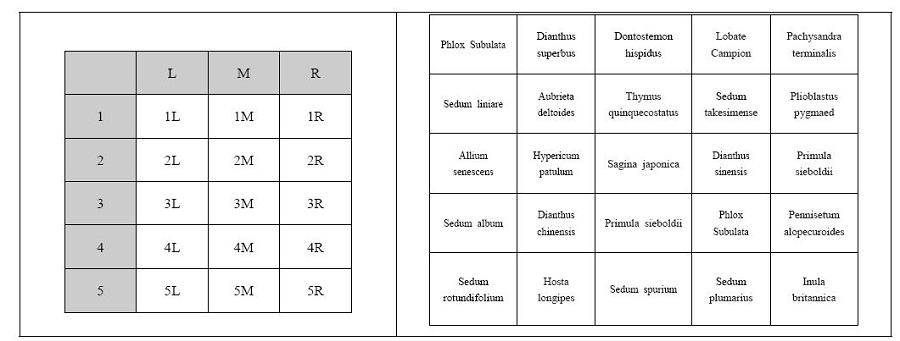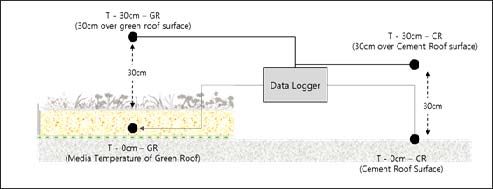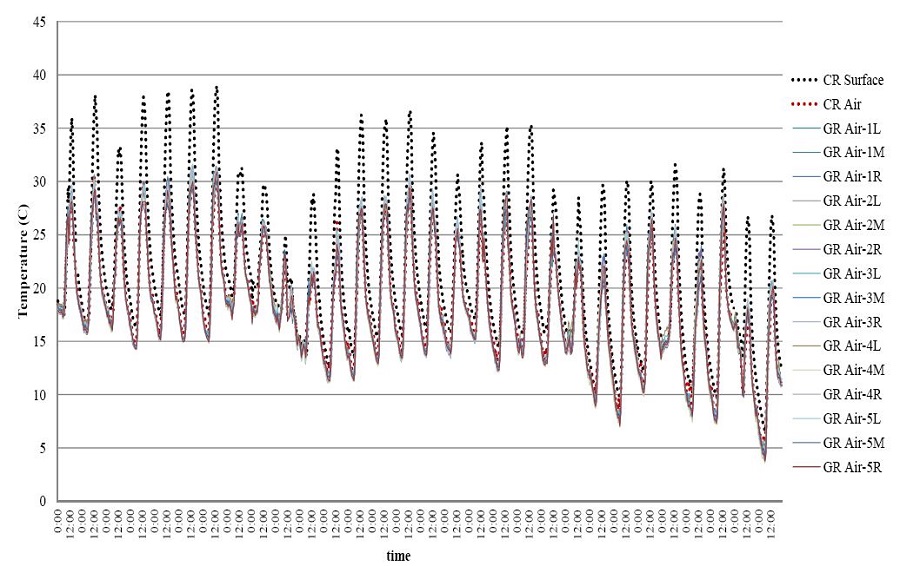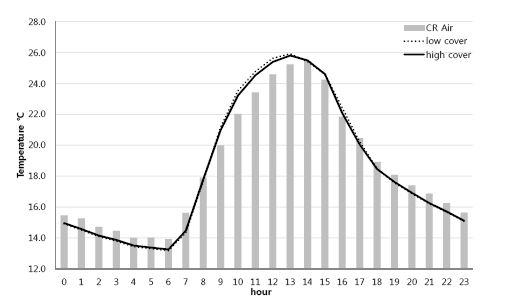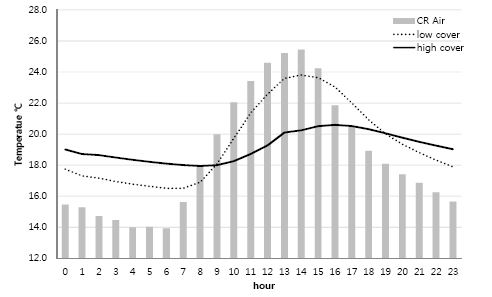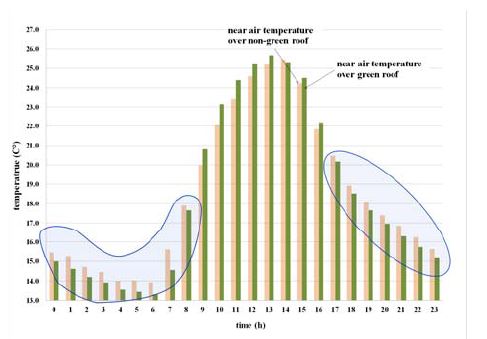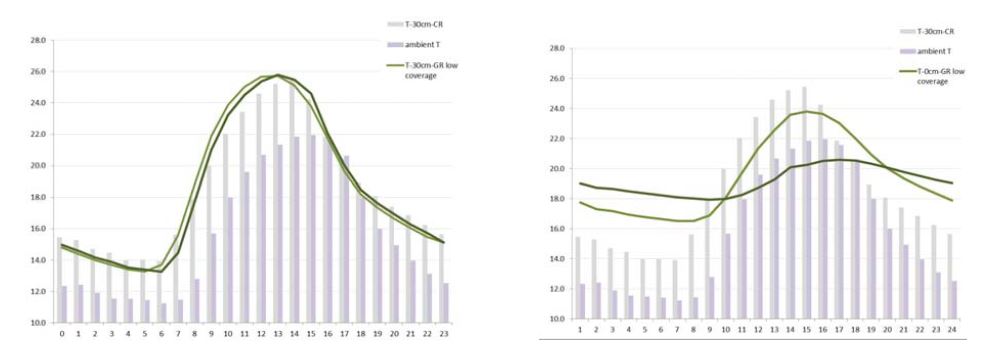
Reduction Potential for Thermal Load by Extensive Green Roofs
Based on the increasing demand for a solution to reduce thermal load, extensive green roofs have great opportunity for application to existing roofs due to their light-weight and easy maintenance. The present study delivers data regarding thermal behavior and heat reduction potential in relation to vegetation coverage between green roof types. 1) In the hottest hour in a day, green roofs showed considerable potential to mitigate heat load in roof environments, which can be up to 10°C difference. 2) Compared to conventional cement roofs, the extensive green roofs only have a slight potential to cool the air over green roofs. By statistical analysis of linear regression, green coverage has little to do with the reduction of air temperature; the cooling effect was proven only in nighttime. 3) Green roofs act as an insulating roof membrane, the inner substrate of green roofs remained cooler than cement roof surfaces in the daytime, but in the nighttime the green roofs generally were warmer than the cement roof surfaces. 4) The variable of vegetation coverage resulted in no significant difference in thermal behavior in the air, but had the greatest effect in keeping the substrate cool in the daytime. The high vegetation coverage also hindered the rapid cooling of the substrate in the nighttime, and therefore was warmer than other measured temperatures. In order to draw a clear conclusion to combat urban heat island effect with extensive green roofs, the experiment needs to be applied on a larger scale.
Keywords:
Urban heat island, Vegetation coverage, Thermal load, Extensive green roofs, 도시열섬, 녹화피복, 열부하, 경량형 옥상녹화1. Introduction
1.1 Background & Purpose
Excessive surface sealing and 3-dimensional building mass in urban areas have led to climate changes in cities which in turn have accelerated global warming effects and aggravated urban climates in return(Oke, 1987; Unger, 2004). The consequences resulting from urban climate change are the urban heat island and urban heat waves in summer months and are factors that seriously threaten urban citizens and aggravate the quality of living conditions (Wanphen and Nagano, 2009; Getter and Rowe, 2006).
The benefits of green roofs have been long investigated in many countries worldwide (Koehler et al., 2002; Liu and Minor, 2005; Getter and Rowe, 2006; Wong, 2003). To realize such environmental benefits effectively and sustainably, the green roof technology should be well designed according to specific urban environment requirements and applied on demand.
Scientific researchers and urban planners take heed of green roofs, due to their environmental and recreational advantages in intensively built urban environments, green roofs are even regarded as a counteracting measurement against the destruction of natural habitats. Moreover, in Germany, green roofs are often taken as major ecological compensation measures for development projects (Brenneisen, 2003). Even still, in reality, there are deficits in acceptance and understanding of green roofs regarding their environmental performance and benefits (Simmons et al., 2008). The approach in providing understanding to clarify the positive aspects of green roofs, in terms of ecological and environmental performance and visual enhancement in the city, has to be strengthened in order to enlarge the applicability in densely built areas.
Whereas green roof policies, backed by scientific research on the urban heat islands and benefits of green roofs, are generally adopted in few advanced countries, there has been recent research on the thermal benefits of green roofs in Korea (Lee et al., 2005). Korea, which has a continental climate, has great temperature differences between summer and winter. Flat roofs are exposed to extremely high temperatures in the summer and extremely low temperatures in winter, and as a result cause a steep rise in cooling and warming energy demands. The collapse in the national electric supply system in early autumn 2011 shows the high demand on cooling energy even after summer season.
The studies on the mitigating effects of urban heat islands by vegetated roofs in Korea demonstrate that the surface temperature of green roofs can be a maximum of 32℃ lower than the conventional cement roof surface (Park et al., 2010). Kim et al (1999) concluded that daily temperature fluctuations varied from 26~28℃ in extensive green roofs with different thicknesses, while the cement membrane roof showed a temperature range of 23~44℃. In an investigation to compare the thermal performance of extensive green roofs, the green roofs with dense plant growth showed a 1~2℃ lower surface temperature than green roofs with bare soil or scarce vegetation coverage (Lee et al., 2005). Oh (2007) found out that there is no significant temperature difference between 10cm and 20cm thickness. Therefore the mitigation of urban heat could be achieved effectively with extensive green roofs of shallow thickness.
There have been a lot of general comparisons of green roofs to conventional roofs, and it was not until recently that research has been dedicated to show the differences between the performance properties of extensive systems. The present study focuses on the thermal behavior of extensive green roofs dependent on vegetation coverage and substrate moisture. The study will show whether the difference of vegetation coverage of extensive green roofs results in thermal load differnce and how vegetation coverage acts as a thermal reduction factor in green roof substrate and in the air over green roof.
In extensive green roofs the shallow substrate depth acts as a limiting factor for plant establishment and growth in the long term. However, the well desinged extensive green roofs have good performance of long-term plant growth.
The selection of suitable plants is, therefore, of great importance in order to secure its functionality for reduction of thermal potential. This functionality can be insured by using appropriate design compositions of growing substrate, depth, drainage layer, root barrier and plant species adapted to extreme growing conditions. The long-term success of extensive green roofs is dependent on a plant species that is suitable for extreme living conditions, such as shallow substrates and non-irrigation (Bousselot et al., 2011). The present study should be able to present results that are appropriate for green roof practices and policies in Korea.
1.2. Materials and methods
Experimental plots were installed on April 30, 2004 on a 5 story building in Goyang, Korea. Five different substrate types were replicated three times Table 1, using five 1×1m square plots, a total of 15 experimental square plots were assembled. The substrate compositions were selected for their robust use in Korea(Table 1; Table 2) A total of 25 different perennial plants and small shrubs were planted in the plot boxes of 1×1 m (Fig. 1), the experimental site was not altered by any kind of maintenance; such as additional irrigation, fertilization, weed removal, insecticide etc. The plant composition shows a completely different pattern from the initial planting 8 years ago; with a small number of the plants remaining, the majority of the initial plants have perished, and unintended wild plants have been established in their stead (Fig. 1)
To measure temperatures, 32 thermocouples are placed:15 thermocouples in substrate (T-0cm-GR), 15 ones 30cm over the substrate surface of the green roof (T-30cm-GR) (see the abbreviation of temperature measure points in Fig. 2), and one on the rooftop surface (T-0cm-CR) and another in the air 30cm over the roof surface (T-30cm-CR). Silicone was used to seal the periphery of the temperature probe wires.
Thermocouples, as temperature sensor for measurement, converted a temperature gradient into electricity every 10 minutes and were fed to a data logger (SQ-1000, Grant Instruments Ltd Shepreth Cambridgeshire UK). Starting from September 19 to October 18, 2012 a data logger gathered temperatures at 10 min intervals. The hourly data was analyzed even further to find the differences between the green roofs (GRs) and the conventional cement roof. Table 3 shows an overview of experiment design and data measure.
In order to elucidate the effect of substrate moisture on the temperature, substrate volumetric moisture content (VMC) was recorded daily for each plot box using a Soil Moisture Meter D-18 (TAKEMURA ELECTRIC WORKS Ltd, Tokyo, Japan). The moisture measure sensors were inserted into the substrate, three random spots per plot considering vegetation dispersal, and measured with a distance of at least 10mm from the edge of the plot box. The gathered values were averaged per plot.
From the overhead photos taken from each plot, the vegetation coverage was calculated using the program eCognition Developer(version 8).
Statistical analysis was conducted on the data using the program PASW 18 (SPSS Inc.). The temperature data was converted to hourly averages for each individual plot and compared within and among treatments using the repeated measures analysis of variance (ANOVA). This analysis method attests the equality of the averages of the tested groups, and whether or not the data was normally distributed. The data set was collected through repeated measures on experimental plots exposed to a number of different conditions through time (Little et al. 1998). Measurements of the temperature performances in substrate (T-0cm-GR) and of the air 30cm above the substrate (T-30cm-GR) were analyzed by the means of a repeated measures analysis of ANOVA. The statistically significance level (p-value) was set at 0.05.
Furthermore, the data sets were made in order to elucidate the effect of vegetation coverage on temperature differences. The linear regression analysis was conducted for the observed data of different green roofs compared to the cement roof, using the vegetation coverage as an independent variable, and moisture and temperature difference as the dependent variables.
2. Result
2.1 Total of temperature
As expected, there was a 24-hour fluctuation pattern in all the observations of air, roof and substrate temperature throughout the course of the day. The temperatures over green roofs and cement roofs as well as roof surface reached their peak around 14:00, while the green roof substrates and the ambient temperature had daily highest temperature about 15:00 or 16:00 one or two hours earlier.
While there was only a small difference between air temperature over green roofs T-30cm-GR and cement roofs T-30cm-CR, the cement roof surface(T-0cm-CR) was always higher than the others(Fig. 3 and 4).
Compared to T-30cm-CR and T-0cm-CR, the green roof substrate had a reduced daily temperature fluctuation. The difference between the daily high to the daily low temperature was smaller than the cement roof which showed a much higher daytime temperature and much lower nighttime temperature in T-0cm-CR and T-30cm -CR(Fig 4). The figure 4 reveals the different behaviors between green roof substrates, which means that temperatures varied by substrate types and their vegetation. Throughout the experiment period, the maximum ambient temperature (September 23, 2012) from the weather station of Goyang City was registered at 26.5℃. On this day T-0cm-CR was 38℃. On the same day, the maximum of the T-30cm-GR remained between 29 and 30℃, almost identical to the T-30cm-CR. By contrast, the T-0cm-GR remained in a range of 22 to 29℃. The peak temperature difference between the observed temperatures also makes a clear distinction in the substrates. The difference between the peak temperature of the roof surface and substrate temperature is greater (9.5 K on average) than that of the roof surface and air temperature of green roofs (6.4 K on average), which indicates green roofs are able to cool both air temperature and building roof surface.
The hourly mean temperature was given to a one-way repeated measures analysis of variance. As shown in Table 4, the calculated F value is greater than the degree of freedom(df) at an alpha level of 0.05, both within the groups and between the groups. There exists a statistically significant effect for temperature
means of the green roof plots in this experiment. There is a difference among the temperature registered in plots.
The total of temperature data was merged into average hourly means of two groups, one for T-30cm-GR(Fig. 5) and one for T-0cm-GR(Fig. 6) . The data groups are compared respectively, with T-0cm-CR and T-30cm-CR. The T-30cm-GR showed a similar behavior among them despite the differences in location, vegetation, and substrate composition and denoted only a narrow difference in temperature in the day's development. Generally the T-30cm-GR were much cooler than the T-0cm-CR, but compared to the T-30cm-CR only a small difference was discovered. The fact that the T-30cm-GR didn't differ from each other, by and large, indicates that vegetation composition and its coverage did not have a great influence on air temperature over green roofs for the given experimental conditions. Nevertheless, throughout the day, roof surface temperatures were higher than the air temperatures over green roofs as well as cement roofs, except in the morning time between 7:00 and 9:00.
T-0cm-GR(Fig. 6) show a more heterogeneous pattern in daily temperature behavior compared to T-30cm-GR. The influence of vegetation as well as substrate composition on substrate temperature is more obvious. Between substrate
temperatures, there was larger divergence compared to air temperature of green roofs. This can be ascribed to the fact that vegetation composition and its coverage have more
influence on the inner substrate temperature than on the air above. The green roof substrate have the highest temperature mean between 20.2℃ and 24.8℃ while the roof surface has 31.9℃.

Repeated measures analysis of variance (ANOVA) associated with comparisons made with the hourly mean temperature of air 30cm over green roof plots
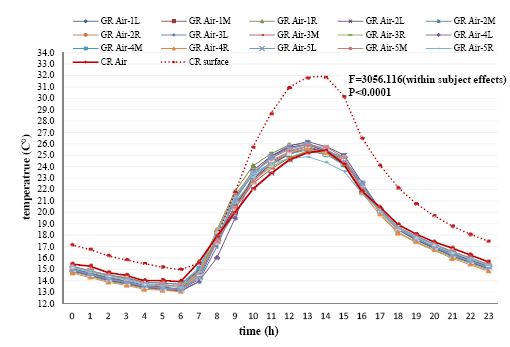
Total mean of T-30cm-GR on the time axis from September 19 to October 18. Repeated measures ANOVA statistics indicate the statistically significant difference in comparisons between groups at a=0.05 level.
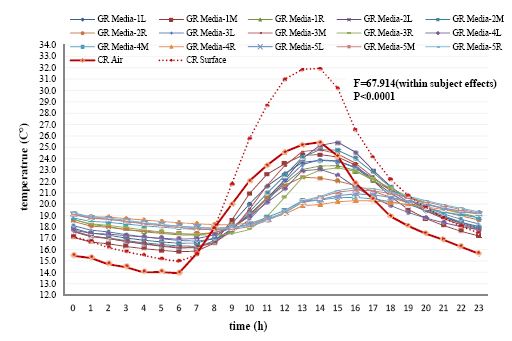
Total mean of T-0cm-GR on the time axis from September 19 to October 18. Repeated measures ANOVA statistics indicate the statistically significant difference in comparisons between groups at a=0.05 level.

Temperature of air and substrate in green roofs (the upper 3 graphs are the green roof with low vegetation coverage, the lower 3 with high vegetation coverage, see figure 1 for abbreviation of the plots)
Fig. 7 demonstrates two groups of selected samples of the green roof plots, in which the left column graphs are the plots with lower than 50% vegetation coverage and the right column graphs are the plots with dense vegetation coverage of 100% coverage. The substrate temperature was compared to the air temperature over the green roof. The plots with lower vegetation (left column) reveals a small difference between air and substrate temperature, whereas the ones covered densely with vegetation show a large difference between the air and substrate temperature. The comparison indicates that the high vegetation cause to lower the daytime temperature in substrate, while low vegetation coverage doesn't hinder the temperature increase in substrate.
The peak temperature reveals some differences in both comparisons(Fig. 7). The surface reached its temperature peak at 14:00 while green roof substrate reached it in a broad range of time between 13:00 to 17:00 whereas green roof air had its peak at 13:00. The air temperature reached its maximum earlier than the substrate and the roof surface.
To determine whether the vegetation coverage has influence on temperature formation, the green roofs were analyzed after division into two groups; one group for lower vegetation coverage less than 50% and one for high coverage with almost 100%. For each, the magnitude of the gap between air and substrate temperature were determined by the hour of the day. The green roofs with sparse plant growing showed a smaller temperature gap between air and substrate temperature; the substrate was cooler(up to 4.2℃) in the time between 8:00 to 17:00 than the air above, but during the rest of the hours it was warmer(up to 4.3℃). For the green roofs with dense plant growth, the turning point at which the air temperature surpassed the substrate temperature was 9:00 in the morning, which lasted until 18:00 in the afternoon at which time the substrate temperature was then again higher than the air temperature. In densely covered plots the greatest diurnal difference between substrate and the air over the green roof was 6.4℃ at 12:00 in GR~2M, whereas the greatest nocturnal gap was 5.2℃ at 6:00 in the morning. The mean temperature of three densely growing green roofs was 19.0~19.2℃ (standard deviation: 0.8~1.1℃), whereas the 3 sparsely growing green roofs had a mean of 19.3~19.5℃(standard deviation: 3.1~3.2℃).
As shown in Fig. 8 and Fig. 9 the difference of the vegetation coverage has no significant influence on the air temperatures of green roofs, that is independently of the coverage the air temperature over green roofs had a similar thermal behavior. But the vegetation coverage had an influence on the substrate temperature : The GR substrate with dense vegetation coverage was subject to smaller daily fluctuations, whereas the ones with sparse vegetation had greater temperature fluctuation, which means the GR substrate of the sparsely growing area substrate was more sensitive to the temperature than the densely covered GR.
For further analysis a data set was defined into core diurnal hours from 11:00 to 13:00 and core nocturnal hours from 04:00 to 06:00 in the morning. For the same data set, analysis of variance(ANOVA) of regression was used to determine the significance of the regression relationships between the green coverage and the core diurnal and nocturnal temperatures, respectively (Table 5)
The air temperature over the green roof was on average, 3.8℃ higher than the green roof substrate, and the range was between 0.7 and 6.1℃ in the early morning before sunrise. By contrast, around noon where the ambient temperature was the warmest, the difference between the T-0cm-GR and the T-30cm-GR was on average -3.8℃ with the range from 0.2℃ to –5.4℃.
The recorded data were further made to obtain the relationship between the plots and its vegetated coverage; the diurnal mean was averaged from the temperature between 12:00 and 15:00, and in the same way the nocturnal mean for the hours from 03:00 to 06:00. Also maximum as well as minimum temperature of average mean was derived from the original data. Table 6 shows only the data of green roof substrate because statistical analysis of linear regression on the air temperature delivers no correlation between the air temperature as the dependent variable and the green coverage as independent variable. Additionally, it should be noticed that the moisture value as the independent variable has no differential significance on temperature development. In diurnal hours from 12:00 to 15:00, in general, the higher vegetation coverage resulted in a lower substrate temperature (R2=0.570, P-Value=0.006*). However in nocturnal hours from 03:00 to 06:00 the increase of vegetation coverage and moisture value showed an increase in the substrate temperature (R2=0.468, P-Value=0.023*). Maximum and minimum mean temperatures show a similar trend. The highest temperature of the maximum mean was found in the green roof with low vegetation coverage (R2=0.474, P-Value=0.021*) and the low temperature of minimum mean was also measured in green roof with low vegetation coverage (R2=0.429, P-Value=0.035*).
3. Discussion
The present study focused on addressing the influence of extensive green roofs on the thermal environment around the building roof. Green roofs draw the attention to their reduction potential of air temperature and inner building heat load. Whether or not the analyzed results have significance on the air temperature and the traits of roof surface temperature will be discussed.
3.1 The cooling effect of green roofs on the air temperature
For the given extensive green roof plots evaluated from September 19 to October 18, the effect of extensive green roofs on the thermal environment was obvious. The comparison of the air temperature between the green roofs and the cement roofs showed a different thermal effect, however it was dependent on the time of the day. Around noon, between 12:00 and 15:00, and for a brief period of time around 16:00, the T-30cm-GR was higher than the T-30cm-CR (Fig. 10). Most of the time, the T-30cm-GR was cooler than the T-30cm-CR. This thermal difference was confined within a limited temperature grade, but taking into account the experiment time, which was in the early autumn months, as well as thermal disturbance resulting from the plot size of 1×1m, and the inducing thermal side effects from near roofs, the potential to lower the thermal heat of the air over the building roof appears considerable.
3.2 The effect of heat load reduction potential of extensive green roofs
The results from the comparison of cement roof surfaces and substrate shows a distinct difference (Fig. 11) .The rapid cooling observed during the times close to nocturnal times was contrasted to the steep heat gain after sunrise in the morning. This was caused by thermal conductivity and specific heat of the conventional cement roof deck (Desjarlais et al., 2010). The conventional roof experienced its average maximum temperature of 31.9℃ at 14:00 for the experiment period, which meant heat load into the buildings inner space (Wong et al., 2003). The green roof substrate shows a more temperate thermal behavior in contrast to the surface; while extreme heating in the diurnal time period and abrupt cooling in the nocturnal time period was dominated by conventional roof surfaces, the green substrate was characterized, as expected, by a tempered thermal fluctuation between nighttime and daytime. For extensive green roofs with a substrate depth of 10cm, the heat increase in the diurnal time period proceeded moderately and the process of heat loss was slow as well (Jim & Tsang, 2011, Nardini et al., 2012). Therefore the green roof experienced much lower temperature fluctuations than the roof surface. As expected, the green roof acted as a thermal buffer layer in the roof environment. The thermal overheating was hindered by substrate and vegetation during daytime, which in turn prevented the occurrence of extreme thermal heating and the following thermal burden on the inner building. The highest temperature mean of the substrate was discovered at 15:00 with 22.9℃; it reached its thermal peak one hour later than the roof surface, so the green roofs show thermal delays relative to conventional roofs.

Summary of temperature means of diurnal, nocturnal, maximum and minimum in green roof substrate of 15 green roof plots
3.3 Effect of vegetation coverage on thermal behavior
It is one of the main interests of this study to show how effective vegetation coverage of extensive green roofs are in cooling temperatures surrounding green roofs. Nowadays the mitigation potential of air temperature is of great interest because green roofs have been widely acknowledged for their contribution in mitigating the urban heat island effect. The substrate layers work as a kind of isolation for the roof deck for the reduction of heat transfer into the building.

Comparison of substrate and cement roof temperatures. In the area marked with red line, the surface temperature of cement roof was higher than green roofs
To illustrate the effect of vegetation density on temperature, both groups shown in Fig. 10 were summarized in two graphs (Fig. 12). The differing levels of vegetation coverage didn't result in a significant variation in air temperature over green roofs (T-30cm-GR), thus both low and high vegetation coverage shows no significant difference in outcome temperature. This aspect is more clear when T-30cm-GR are compared to ambient temperatures. This means the air temperature over the roof, apart from whether the roof is covered green or not, was always higher than the ambient temperature, but compared to cement roofs, extensive green roofs were still cooler in the day, and vice versa in the night. The higher air temperature of green roofs in the night indicates the latent heat in substrate moisture works as a delaying mechanism against cooling of the air above.
The substrate temperature showed a different curve of temperature throughout the day. While the sparsely vegetated green roofs had a stark contrast showing increase in daytime and decrease in nighttime, the densely vegetated green roofs showed a more moderated temperature development during the 24-hour period.
In the daytime the substrate of the densely vegetated roofs were the coolest, but in the nighttime they were the warmest in comparison to the roofs with sparse vegetation, T-30cm-GR, and ambient temperature. The reason is that in the daytime the plants shaded substrate surface effectively and vegetation removed heat from the air through transpiration and the latent heat transfer mechanism. In the nighttime the water content in the substrate and dense vegetation acted as an attenuating factor in temperature change in green roofs.
4. Conclusion
Based on the increasing demand for a solution to reduce the thermal load on building(Liu & Baskaran, 2005; Alcazar & Bass, 2005; Del Barrio, 1998) extensive green roofs have great opportunity for application to existing roofs due to their light-weight and easy maintenance. Apart from previous existing studies focusing on the thermal behavior of extensive green roofs in contrast to conventional cement roofs, the present study delivers data regarding thermal behavior and heat reduction potential in relation to vegetation coverage in green roofs. The performances of extensive green roofs were analyzed and compared to the air and surface temperatures of cement roofs as well as air and substrate temperatures of green roofs.
The analysis of thermal differences between the substrate and cement roof surfaces, on average, in the hottest hour of a day, shows the considerable potential to mitigate heat load in roof environments. The conventional roofs made of cement were characterized by large thermal fluctuations between daytime and nighttime. The highest temperature mean measured in the cement roofs was 31.9℃, and ranged in green roof substrate between 20~25℃. This indicates the green roof
can reduce the temperature significantly in the hottest hour of a day. The reduction potential is of great significance in reducing heat load on the building surface.
The performance of extensive greens roofs to cool air temperature has to be critically scrutinized because statistical analysis of linear regression showed that green coverage has little to do with the reduction of air temperature; only a slight cooling effect was proven in nighttime. During the daytime the green roof air temperature was marginally higher than the conventional roof, but in the night the former was slightly cooler than the latter. This difference in temperature is far lower compared to the surface temperature reduction by green roofs, but taking into consideration that the size of the plots was 1x1m2, and that the experiment was done in early autumn, the benefit from the green roof, to cool ambient temperature, was considerable. The comparison of air temperatures over the green roofs with the cement roofs revealed that the air temperatures over the green roofs were, in nocturnal hours, cooler than over the cement roofs by a range of 0.5 to 1.3K.
According to statistical analysis of linear regression, green coverage had no significant correlation with the temperature of the air, but had a significant influence on substrate temperature. The dense plant development in extensive green roofs lead to the reduction of substrate temperature during diurnal hours, but quite contrary to this, was warmer than the green roofs with low coverage in nocturnal hours. This could be due to the high vegetation coverage that hindered the rapid The investigation of cooling performance by different vegetation forms reveals biomass quantity and structural complexity have a important role in passive cooling of roof surface, grass cover could cool more effectively compared to ground cover and shrub, but in the night they showed no better cooling effect than the control roof (Jim, 2012). In Athen, Plants’ Leaf Area Index (LAI) was regarded as a highly affecting factor to cool green roofs’ surface temperatures due to the high shading effect(Kanellopoulou 2008). This aspect needs to be studied further in a larger experimental scale and in other seasonal periods to better design extensive green roofs to combat urban heat island effect and to improve the thermal environment of the building.
This study, neither in part or in whole, has been published nor accepted by another journal. The experiment complies with the current laws of Korea.
Acknowledgments
This research was supported by a grant from the project Development of 3-dimensional greenery system to building structures in Eco Innovation Program funded by Ministry of Environment of Korean Government under grant No. 403-112-006. The authors are grateful to Joseph Kim MSN, CCRN for his peer review, and editing.
Notes
References
- Alcazar SS & Bass B, Energy performance of green roofs in a multi storey residential building in Madrid. University of Toronto, (2005).
- J Bousselot, JE Klett, RD Koski, Moisture content of extensive green roof substrate and growth response of 15 temperate plant species during dry down, HortScience, (2011), 46(3), p518-522.
- S Brenneisen, Oekologisches Ausgleichspotenzial von extensiven DachbegrueungenBedeutung fuer den Arten- und Naturschutz und die Stadtentwicklungsplanung, Doctoral dissertation, University of Basel, Switzerland, (2003).
-
EP Del Barrio, Analysis of the green roofs cooling potential in buildings, Energy and Buildings, (1998), 27, p179-193.
[https://doi.org/10.1016/S0378-7788(97)00029-7]

- AO Desjarlais , A Zaltash, JA Atchley, Thermal Performance of vegetative roofing system, Proceedings of 25th RCI International convention http://www.ornl.gov/sci/ees/etsd/btric/pdfs/ThermalPerfofVegetatedRoofSystems_Mar2010.pdf, (2010).
- KL Getter, DB Rowe, The role of extensive green roofs in sustainable development, HortScience, (2006), 41(5), p1276-1285.
-
CY Jim, SW Tsang, Ecological energetics of tropical intensive green roof, Energy and Buildings, (2011), 43, p2696-2704.
[https://doi.org/10.1016/j.enbuild.2011.06.018]

- HS Kim, JS Kang, HS Pyon, A study on the development of roof-planting system and its thermal performance, Architectural Research, (1999), 15(3), p127-134.
-
M Koehler, M Schmidt, FH Grimme, M Laar, VLA Paiva, S Tavares, Green roofs in temperate climates and in the hothumid tropicsfar beyond the aesthetics, Environ Manag Health, (2002), 13(4), p382391.
[https://doi.org/10.1108/09566160210439297]

- DK Lee, SW Yoon, SH Sh, SW Jang, The effect of temperature reduction as infludneced by rooftop greening, J. Korean Env. Res. & Reveg. Tech, (2005), 8(6), p34-44.
- RC Littell, PR Henry, CB Ammerman, Statistical Analysis of Repeated Measures Data using SAS Procedures, Journal of Animal Science, (1998), 76, p1216-1231.
- K Liu, B Baskaran , Thermal performance of green roofs through field evaluation, NRCC-46412. Proceedings for the First North American Green Roof Infrastructure Conference http://archive.nrc-cnrc.gc.ca/obj/irc/doc/pubs/nrcc46412/nrcc46412.pdf, (2005).
- K Liu, J Minor, Performance evaluation of an extensive green roof, In: Greening rooftops for sustainable communities, Washington, DC, (2005), p111.
-
A Nardini, S Andri, M Crasso, Influence of substrate depth and vegetation type on temperature and water runoff mitigation by extensive green roofs: shrubs versus herbaceous plants, Urban Ecosyst, (2012), 15, p697708.
[https://doi.org/10.1007/s11252-011-0220-5]

- SH Oh, The analysis of temperate reduction effect of an extensive green roof, Master Thesis. Seoul National University, (2007).
-
TR Oke, Boundary layer climates, New York, (1987).
[https://doi.org/10.4324/9780203407219]

- EJ Park, KI Kang, MA Nam, Green roof strategy for mitigating the urban heat island effect, Policy research 2010-25, Gyeonggi Researc Institute pp, (2010), p1-168.
-
MT Simmons, B Gradiner, S Windhager , Green roofs are not created equal: the hydrologic and thermal performance of six different extensive green roofs and reflective and non-reflective roofs in a sub-tropical climate, Urban Ecosyst, (2008).
[https://doi.org/10.1007/s11252-008-0069-4]

-
J Unger, Intra-urban relationship between surface geometry and urban heat island. Review and new approach, Climate Research, (2004), 27, 253e264.
[https://doi.org/10.3354/cr027253]

-
S Wanphen, K Nagano, Experimental study of the perfor mance of porous materials to moderate the roof surface temperature by its evaporative cooling effect, Building and Environment, (2009), 44, p338-351.
[https://doi.org/10.1016/j.buildenv.2008.03.012]

-
NH Wong, Y Chen, CL Ong, A Sia, Investigation of thermal benefits of rooftop garden in the tropical environment, Building and Environment, (2003), 38, p261-270.
[https://doi.org/10.1016/S0360-1323(02)00066-5]

-
NH Wong, KKW Cheong, H Yan, J Soh, CL Ong, A Sia, The effects of rooftop garden on energy consumption of a commercial building in Singapore, Energy and Buildings, (2003), 35, p353-364.
[https://doi.org/10.1016/S0378-7788(02)00108-1]

